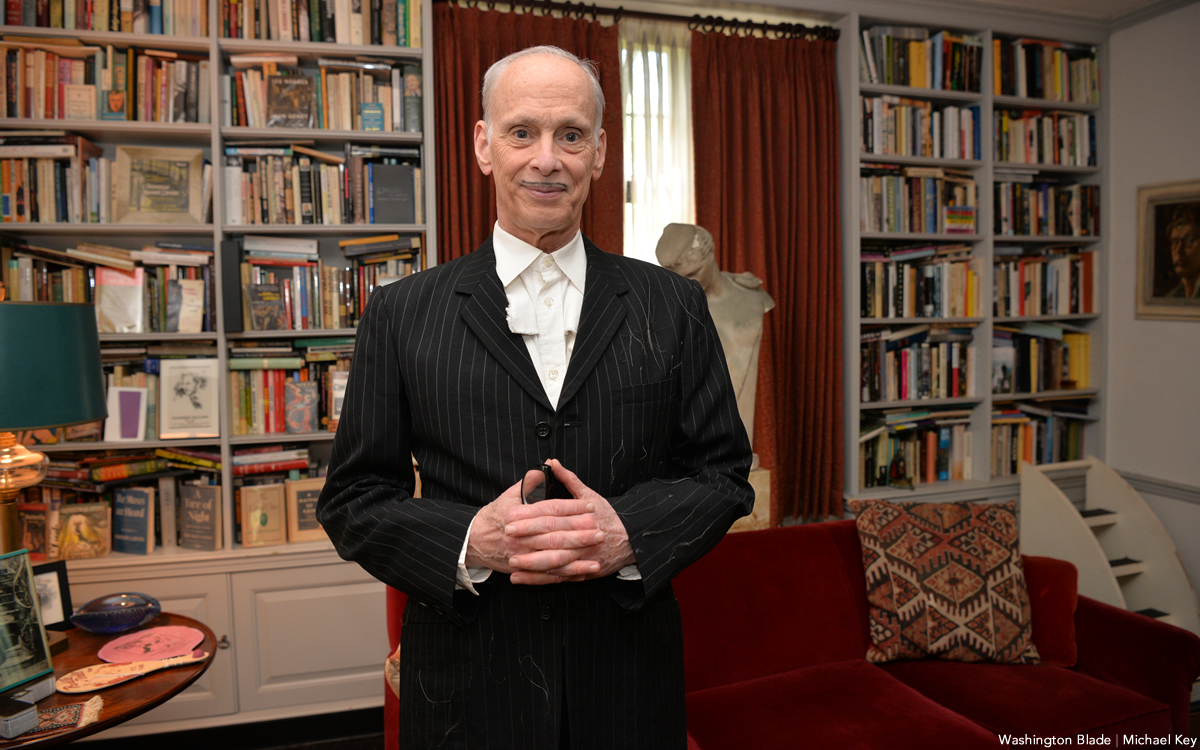a&e features
SPORTS ISSUE 2019: Trans women face many hurdles in quest to compete fairly
Testosterone levels, hormones, evolving policies, anti-trans bias among complicating factors


LGBT issues have never been easy — marriage, military service, AIDS, you name it, no gain came without a fight. But if, as is commonly posited, trans rights lag a good 10 or more years behind gay and lesbian advances, perhaps the thorniest issue of all is fair competition for trans women and their cis women opponents, in both recreational and elite sport.
Imagine that women’s sports had never become “a thing” and all adults competed against each other. In figure skating, for example, only three women have landed quad jumps in competition, yet no male singles skater today can be remotely competitive without multiple quads in his arsenal (Nathan Chen landed six at the 2018 Olympics yet failed to medal).
Yes, Billie Jean King (a lesbian) famously beat Bobby Riggs in the 1973 “Battle of the Sexes” in tennis, but she was 29 and he was 55. What would happen if Michael Phelps and Katie Ledecky (swimming) or Novak Djokovic and Serena Williams (tennis) were to face off in the pool or on the court?
Perhaps more realistically, what would happen if Chen, Phelps or Djokovic came out as trans, opted out of hormone replacement therapy and competed as women? Some LGBT advocates say even suggesting such a scenario is transphobic or, at best, displays a gross misunderstanding of the issue. But it’s a question being asked by many.
The International Olympic Committee changed its policy in early 2016 to allow trans women to compete provided they demonstrate their testosterone level has been below a certain level for at least one year prior to their first competition. It supplants the previous 2003 policy that required both gender reassignment surgery and two years of hormone therapy (trans men are allowed to compete without restriction).
Chris Mosier, a trans male athlete and creator of transathlete.com, a resource site for trans sports advocacy at all levels, says the debate has been unfair and overheated.
“We’ve had several Olympic games since the policy has been in place for trans athletes,” says the 38-year-old Mosier, who in 2015 became the first openly trans man to make a Men’s U.S. National Team when he qualified for the Spring Duathlon team. “We’re talking something like 50,000 Olympians have passed through and not a single trans athlete or single trans woman has participated. The fears people have and the stereotypes and misconceptions they’re putting out there about trans women dominating sports just simply haven’t happened.”
That’s also the argument of trans activist/author Brynn Tannehill whose book “Everything You Ever Wanted to Know About Trans” came out in 2018. She points out that there has not been a single trans athlete dominator since the Olympic policy change or since the NCAA changed its policy to allow trans people to compete sans surgery in 2011. She claims a year of testosterone removal is “sufficient to remove competitive advantage.”
But some cis athletes have balked at getting beaten by trans women competitors. And they’re not just complaining — some are taking legal action. Elsewhere, governing bodies in various sports at all levels are either facing or have faced challenges in how to keep their eligibility policies current and trans-inclusive. That collides with the widely held trans argument that what a trans person has done or not done by way of hormone replacement therapy or gender reassignment surgery is a personal matter that doesn’t make them more or less a woman or man than those at other stages of transition.
Others say trans bias is something impossible to ignore or downplay because it’s so rampant.
“There will always be people who will say a trans female athlete is cheating when she wins or when she doesn’t win, say, ‘She just didn’t try hard enough,’” says gay sports filmmaker David McFarland (“Alone in the Game”). “People are looking for a reason to discriminate against trans people in sport, that’s a given.”
Connecticut controversy
Selina Soule, a 16-year-old runner at Glastonbury High School in Glastonbury, Conn., is frustrated. She says she’s suffered because trans competitors in her conference — Terry Miller of Bloomfield High and Andraya Yearwood of Cromwell High — have been allowed to compete no questions asked against she and her fellow cis women runners.

Miller won the State Open 200-meter title for the second straight year in 2019 and won the Class S titles in the 100 and 200, as well as the New England 200-meter championship. Yearwood, who is also transgender, finished third in the 100 meters in Class S and fourth in the 100 in the State Open.
Subsequently Soule wasn’t able to compete in the New England regional Championships where she would have been seen by college scouts. Miller and Yearwood have won 15 women’s state championships since the Connecticut Interscholastic Athletic Conference (CFAC) changed its policy to allow them to compete as women. Conference leaders say they’re simply following state law.
“The CIAC is committed to providing transgender student athletes with equal opportunities to participate in CIAC athletic programs consistent with their gender identity,” its guidebook reads. Connecticut is one of 19 states that has similar laws.
“I am very happy for these athletes and I fully support them for being true to themselves and having the courage to do what they believe in,” Soule said in a Fox News interview. “But in athletics, it’s an entirely different situation. It’s scientifically proven that males are built to be physically stronger than females. It’s unfair to put someone who is biologically a male who has not undergone anything in terms of hormone therapy against cisgender girls.”
Miller and Yearwood have declined to state publicly what, if any, hormone therapy or testosterone suppression — more on that later — they have undergone.
Soule told the Wall Street Journal the experience has been demoralizing.
“It’s just really frustrating and heartbreaking because we all train extremely hard to shave off just fractions of a second off of our time and these athletes can do half the amount of work that we do and it doesn’t matter,” she said. “We have no chance of winning.”
“It’s definitely a complicated issue,” Soule’s mother Bianca, told the Blade in a brief phone interview. “You have to compete based on the physical abilities you were born with, if you want to call it that. That’s why we separate the two genders. If there were no differences, there would never have been a women’s sports. Unfortunately our trans girls are caught in the middle. The rule is the problem. I tried to contact our Connecticut association to try to look into it, even meet with one of the trans girls’ fathers to try to understand and come up with a solution but we were met with only shut doors. The frustrating part has been the refusal of the athletic bodies to even consider and listen to our side of it.”
Yearwood and Miller issued statements through the ACLU. “I will continue to fight for all trans people to compete and participate consistent with (whom) we are,” Miller wrote. “There is a long history of excluding black girls from sport and policing our bodies. I am a runner and I will keep running and keep fighting for my existence, my community and my rights.”
“I will never stop running,” Yearwood wrote. “I hope that the next generation of trans youth doesn’t have to fight the fights that I have. I hope they can be celebrated when they succeed, not demonized.”
“It is heartbreaking to see yet another attack on trans youth for simply participating in activities alongside their peers,” Chase Strangio, ACLU staff attorney added. “Discrimination on the basis of sex extends to trans people. Girls who are transgender are girls.”
A legal group called Alliance Defending Freedom (it calls itself a “conservative Christian nonprofit”) filed a complaint in June with the U.S. Department of Education Office of Civil Rights on behalf of Soule and two of her teammates claiming they have “been negatively impacted by the policy.”
“One of these male athletes now holds 10 records inside the state of Connecticut that were once held by 10 individual girls established over the course of about a 20-year period so it’s fundamentally unfair to allow biological males to step into women’s sports and frankly dominate them and take away opportunities not just to medal, but to be on the podium and advance to the next level of competition and even compete for scholarships for young women like Selena,” Christiana Holcomb, an Alliance Defending Freedom attorney, told Tucker Carlson on Fox News.

“It’s grotesque and insane and it hurts women and girls,” Carlson said on the broadcast.
The issue is especially acute among high school athletes because students are often just figuring out whom they are, how they identify and are less likely to have time logged living fully transitioned lives.
Dawn Stacey Ennis, managing editor of OutSports and a trans woman, says the trans-girls-bumping-cis-girls-off-the-medal-stand argument is misleading because college coaches recruiting look at time, not placement.
“They don’t care who placed first, second or third — all colleges look at and what every coach has told me is that the time is what matters because time is immutable, you can’t change that. It doesn’t matter if you ran against a trans person or not,” Ennis says.
She also says Soule and her representatives aren’t being totally forthcoming.
“I talked to her mother and watched the video and when she said (Selina) didn’t get to qualify for the event in Boston, she sort of fibbed a little bit. She didn’t qualify in that event, but she did qualify in another event. But, of course, that’s not a good headline. It’s much better to say, ‘I didn’t get to go because of these girls.’ … They have to make the trans girls out to be the boogyemen because somebody else has to be responsible for her losing. It has to be someone else’s fault, but that’s not what sports is about.”
Tennis legend Martina Navratilova, a lesbian, was heavily criticized for a Sunday Times op-ed she wrote in February arguing trans women should not be allowed to compete against cis women.
“It’s insane and it’s cheating,” she wrote. “I am happy to address a transgender woman in whatever form she prefers, but I would not be happy to compete against her. It would not be fair. … To put the argument at its most basic: a man can decide to be female, take hormones if required by whatever sporting organization is concerned, win everything in sight and perhaps earn a small fortune, and then reverse his decision and go back to making babies if he so desires,” she wrote.
She was heavily criticized for her comments, removed from the advisory board of Athlete Ally (an LGBT athlete advocacy group) and called out by trans activists such as cyclist Rachel McKinnon (the first trans woman to win a world track cycling title in Oct., 2018), who called Navratilova’s concern a “wild fantasy worry that is an irrational fear of something that doesn’t happen … transphobia.”
Navratilova wrote of being frustrated with “what seems to be a growing tendency among transgender activists to denounce anyone who argues against them and to label them all as transphobes.”
She backpedaled somewhat, apologizing for using the word “cheating,” but called for a debate on the issue based “not on feeling or emotion but science,” BBC News reported.
How are other sports organizing bodies handling the issue?
Western states solution
One group that’s done about as well as anyone it appears is the Western States 100-Mile Endurance Run whose board members this year adopted a trans-inclusive policy that accepts “a runner’s self-declared gender at registration … at face value,” the New York Times reports.
“If, however, a finisher in the top 10 or among the top three in their age group is challenged, race management may ask the runner for documentation that they have undergone medically supervised hormone treatment for gender transition for at least a year before the race,” the Times reports.
The issue arose last December when Grace Fisher, a trans runner who favors ultradistance competition, was selected through the race’s traditional lottery system for the 100-mile ultramarathon that takes place in the Sierra Nevada Mountains in California every June.
If a trans runner is challenged and it’s upheld by race management, their placement may be bumped but they would be allowed to keep their finisher’s buckle. It ended up not being an issue for Fisher (she came in 20th) but she says she appreciates the care organizers put into their policy.
“They were so concerned about me and wanted to ensure my safety,” says the 38-year-old Hancock, Md., resident, a federal employee with United States Citizenship and Immigration Services. “They went out of their way to welcome me and wish me good luck. … It was quite amazing, but I don’t think the other runners really picked up on it. They just saw me as another female.”
Fisher acknowledges the issue is dicier on the high school level.
“I think we do need more research, but there are so few of us, it’s hard to get more,” she says. “I think personally, and this may not be popular in the trans community, but yeah, the high school situation needs to be looked at more. That’s such a tricky situation because one, they’re teenagers so their hormones are raging whether they’re cis or if they’ve started to transition, they may still have an advantage. I just haven’t seen any science on it so I’m hesitant to state any opinion at this point.”
There’s a bounty of information on the topic available from all kinds of sources, from thorough, balanced studies in popular magazines such as Men’s Health’s March piece “The Truth About Trans Athletes;” to folksy, readable blogs such as “On Transgender Athletes and Performance Advantages” earlier this year at sportsscientists.com; to scholarly research in medical journals such as “Sport and Transgender People: a Systematic Review of the Literature Relating to Sport Participation and Competitive Sport Policies,” published online two years ago on the National Institute of Health website, which studied eight other articles and reviewed 31 sport policies.
The findings were — perhaps surprisingly for some — more trans validating than one might expect.
“In relation to sport-related physical activity, this review found the lack of inclusive and comfortable environments to be the primary barrier to participation for transgender people.” Also, the “lack of inclusive and comfortable environments (is) the primary barrier to participation for transgender people. … transgender people had a mostly negative experience in competitive sports because of the restrictions of the sport’s policy placed on them.”
Researchers also found “no direct or consistent research suggesting transgender female individuals (or male individuals) have an athletic advantage at any stage of their transition (e.g. cross-sex hormones, gender-confirming surgery) and therefore competitive sport policies that place restrictions on transgender people need to be considered and potentially revised.”
The ‘T’ word
A central — but not total — factor in this discussion is testosterone levels.
The hormone, an androgen is produced in both men and women, but not nearly as much in cis women. It affects the body in many ways.
In men, high levels of testosterone are made in the testes. The adrenal glands make much lower levels above the kidneys. Women produce testosterone in both their adrenal glands and ovaries, but testes in men produced much higher rates: in men, it’s 295 to 1,150 nanograms of testosterone per deciliter of blood while the levels in women are usually in the range of 12-61 nanograms per deciliter of blood, according to the New York Times and other medical sites consulted.
Testosterone also builds both skeletal and cardiac muscle and increases the number of red blood cells. The effects are present whether they’re there naturally or introduced. The effects are amplified further among elite athletes and make a huge difference in performance. Male champions in sports across the board are always faster and stronger than records set by women, although it’s not as simple as it may appear at first: researchers have found it has more of an effect in middle-distance races; it could have been less of a factor for Fischer in the Western States 100.
But the connection between testosterone and athletic performance isn’t always an exact science. When researchers measured the T levels of elite athletes from 15 Olympic sports, more than 25 percent of the men were below the level (10 nanomoles per liter) required of trans Olympic women, according to a study from “Clinical Diabetes and Endocrinology” cited in the aforementioned Men’s Health article. Nearly 7 percent had less than 5 nmol/L and there was significant overlap between male and female athletes. Cis male powerlifters had surprisingly low T levels while cis male track and field athletes were higher.
Further complicating matters is the fact that some cis women rarely but occasionally possess unusually high T levels. Caster Semenya, 28, an elite runner and Olympic champion from South Africa, for instance, has been banned from some races. In May, the Court of Arbitration for Sport in Switzerland ruled that women with unusually high T levels (far above the ranges normally seen) cannot compete against other women in some races unless they take drugs to suppress their levels, the New York Times reported.
Men also tend to be on average about 6 inches taller than women. The average U.S. adult male weighs 195 pounds vs. 168 pounds for women. A study from the Applied Physiology journal found that men had an average of 26 pounds more skeletal muscle mass than women and about 40 percent more upper-body and 33 percent more lower-body strength on average.
Fairness factor
So what does fair look like?
Mosier chuckles when asked to ponder the issue with sexism, patriarchy and anti-trans bias taken out of the equation.
“I don’t know what that would look like and I wish I could predict the future,” he says. “But sport is inherently about advantage and that makes people uncomfortable. There are certain advantages a very tall basketball player has. We don’t ask him to chop off a few inches of their height to make a more level playing field. Some people burn lactic acid faster than their competitors. At the 2016 Olympics in Rio, Katie Ledecky, beat her competition by a full pool length but she’s thought of as a once-in-a-lifetime, exceptional athlete but her advantage may be that she is never questioned, but there really needs to be more studies done on what the impact is over time before anyone could start to talk about unfair advantage.”
Not disqualifying certain individuals with extraordinary physical gifts is also commonly used as a rationale for why trans women shouldn’t be punished for physical attributes beyond their control.
“What are they supposed to do, tell these people they can’t compete because their arms are too big or their torsos are too long,” Ennis says. “That’s not fair either. Trans girls may have physical gifts but I would hope those would be advantages that would make cis girls try harder. I don’t think it’s unfair because there are always going to be people who are better than you.”
McFarland agrees.
“It’s an affront to every athlete to be penalized for one’s intrinsic biology,” he says. “Do we tell a really strong female shot putter or discus thrower she’s too strong to compete? Do we have a height cut-off in the NBA? Where would it end?”
But by that argument, why are women’s divisions needed in any sport?
Ennis says no women — cis or trans — want to compete against men. Asking the question, she says, implies skeptics don’t see trans women as true women.
“This idea that some guy’s gonna go put on a wig and a skirt, go dominate the sports world, then go back and start fathering babies, that’s just not what the trans experience is about,” Ennis says.
Mosier says any advantage trans women in theory may have, is negated by the social stigma they endure.
“It has a huge impact on their training and performance,” Mosier says. “People aren’t transitioning to gain a competitive advantage. What they encounter would never offset a gold medal or world championship. They just want to compete. … The footage of some of these track meets and what’s said to the competitors and their parents, its’ really toxic and vile and horrific in so many ways that a young person would have to deal with that lack of understanding.”

(Photo by Zhen Heinemann; courtesy Mosier)
And while some argue that anyone who’s been through a male puberty will on average retain a physical advantage — testosterone doesn’t vastly impact one’s height or reach — Fisher says even that argument is suspect.
“It’s like having a Mustang with a small engine,” Fisher says. “You still have this big car but it just doesn’t have the engine. We lost a lot of muscle mass, probably more than a fit female, but also a lot more bone mass. The muscle-to-mass ratio is lower,” she says. “I don’t really know if trans women have any advantage. I think it’s questionable.”
As one would expect, there’s huge support for trans athletes — both men and women — among LGBT advocacy groups. But the story changes significantly when you loop other stakeholders into the discussion.
Fallon Fox was the first openly trans athlete in MMA history in a 2012-2014 career that included just a single loss. She encountered substantial transphobia in her groundbreaking career but also questions about the fairness of her bouts. During a 2014 fight against Tamikka Brents, Brents suffered a concussion, orbital bone fracture and required seven staples to her head after the first round, which ended the fight. Brents, a lesbian, said after the fight it wasn’t a fair match.
Brents declined a Blade interview request saying she’d put the issue behind her but said at the time that Fox was far stronger than any other women she’d ever fought in a long MMA career.
Fox dismissed the advantage claim in a guest editorial on an MMA news website saying, “I’m a transgender woman. I deserve equal treatment and respect to other types of women. I feel this is so ridiculously unnecessary and horribly mean spirited.”
Elusive consensus
While it’s understandable that consensus eludes the sports world among the Alliance Defending Freedom, Fox News and the like, it’s still thorny because there’s no consensus either among trans people.
Some believe trans athletes should be able to compete without any medical intervention at all, others believe in a physical barometer to gauge trans eligibility while others say there should be a separate league for trans athletes, not a widely held view because of their small numbers. They mostly agree, however, that participation is essential.
Ennis of OutSports says the fact that trans women haven’t emerged as a dominant force in elite sports and even in high school sports don’t win constantly helps support the general push toward trans inclusion.
“If a study were to come out and say conclusively that trans women are physically unbeatable by cisgender women and every cis woman lost every time, I would throw in my hat and say, ‘That’s it, we can’t do it.’ But the facts aren’t in. Cis women do beat trans women. Not every single time, but there’s not one sport in which trans women totally dominate. These two (Connecticut) high school girls are winning competitions, but they don’t win every single one they’re in.”
“No trans person is trying to participate for personal gain,” McFarland says. “They just want to do it in a healthy manner. This idea that people are transitioning just to dominate is something that critics continually get wrong and this ungrounded fear of trans people, that they’ll come in and take over, that’s really the dictionary definition of transphobia. … The current science and data reveals it’s a nonsense argument.”
a&e features
Have yourself a merry John Waters Christmas
Annual holiday show returns to Alexandria and Baltimore

When it comes to iconic Christmas scenes in movies, none can top the tree-toppling tantrum thrown by cha-cha heels-deprived Dawn Davenport in John Waters’s fifth full-length feature “Female Trouble” from 1974. Therefore, it’s not surprising that Waters continues to make art out of Christmas, performing his spoken word Christmas tour in cities across the country. Waters has even more reason to celebrate with the release of his new red vinyl 7” single, a cover of Little Cindy’s “Happy Birthday Jesus (A Child’s Prayer)” on the A-side, and “A Pig Latin Visit From St. Nicholas” on the B-side. If you’re still looking for unique Christmas gifts, consider this record. As always, John was kind enough to make time for an interview in advance of his tour dates.
BLADE: John, in preparation for this interview with you, I went back and listened to Little Cindy’s original rendition of “Happy Birthday Jesus (A Child’s Prayer)” on your “A John Waters Christmas” CD.
JOHN WATERS: One thing I did, if you notice, I make the same stumble in my recording that she did in the original.
BLADE: It sounded to me like she got choked up.
WATERS: No, I think she just stumbles over a word, so I stumbled over the same word. It’s appropriation, insanely.
BLADE: Is this a song you first became aware of in your youth or when you were an adult?
WATERS: When I was doing the Christmas album, I had this friend named Larry Benicewicz. He was kind of my idea man with music. He knew every single old record. I would say to him, “Weird Christmas songs,” when we were doing a soundtrack, or a song about bears, or a song about this, and he would give me all these tapes. It was one of the ones he played for me. A lot of the songs I put in my movies and on my records, I did know as a kid. I did not know this one, but I immediately embraced it. I don’t think it’s campy. I think it really is spiritual in a weird way. My doing it makes it a novelty record. I am really for novelty records, and there aren’t any anymore. Why was there not a COVID novelty record? That’s insane. The dance “The Bug” that’s on the “Hairspray” soundtrack would be perfect for COVID.
BLADE: The thing that struck me was that for a Christmas song in the voice of a child, a kind of death pall hangs over it, with lines like, “If I was good you’d let me live with you” and “they nailed you to the cross, they wanted you to die.”
WATERS: All of it! When I see children at midnight mass kneeling in front of a nude man nailed to a cross, I feel like I’m at The Eagle! It is S&M, it’s creepy. I took the same cover (photo) from her record to parody and put my face on it. The same thing I did with The Singing Dogs last year when I covered (their version of) “Jingle Bells.” I’m really into novelty records. I love them and I’m trying to bring them back. I don’t expect anybody to ever play these records. Even The Singing Dogs one said on it, “Please do not play this record” [laughs]. And the flipside, the Pig Latin version, is almost impossible to listen to.
BLADE: I’m so glad you mentioned that. “A Pig Latin Visit From St. Nicholas” reminded me of the lost art of speaking in Pig Latin. I also recall watching the PBS series “Zoom” as an adolescent and learning to speak “ubbi dubbi,” a distant relative of Pig Latin. Do you think that the time is right for a Pig Latin or ubbi dubbi revival?
WATERS: Here’s the thing, I never could pick up any language, except Pig Latin. I’ve been in every foreign country. Foreign countries have given me money to learn to speak the language. I can never do it! But Pig Latin…my parents and other parents in the ‘50s spoke Pig Latin so kids couldn’t understand what they were saying. Then my mother taught it to me, and I used it. The hardest take to shoot in “Pink Flamingos” was not eating the dog shit. It was when the cast skipped, in one take, saying “E-way, are-yay e-they ilthiest-fay eople-pay in-hay e-they ole-hay ide-way orld-way.” We’re the filthiest people in the whole wide world in Pig Latin. We had to do so many takes so they could do it once without screwing it up. In “Polyester,” Edith (Massey) answers the phone, “ello-hay.” I did a photo piece where it was all subtitled in Pig Latin. Like “osebud-Ray” (from “Citizen Kane”) or in “Streetcar,” “ella-Stay!” [Laughs] All the iconic dialogue translated into Pig Latin. My assistant who helped me do it, had never heard of Pig Latin. She really got good at it because she lived in many foreign countries and can pick up languages. But it’s not that easy to do it correctly and read it. Your computer will translate into Pig Latin.
BLADE: AI understands Pig Latin?
WATERS: I guess that’s AI. It wasn’t 100% right, but it was close. I can speak it if I look at it, but just do a bit at a time. It was a challenge that no one would possibly care about or want to do.
BLADE: I think you pulled it off very well.
WATERS: If you want people to leave on Christmas morning, you put it on. That’s how you get your guests to leave. It’s time to go.
BLADE: Ood-gay i-bay! How did your relationship with record label Sub Pop, which released 2021, 2022, 2024, and new 2025 holiday singles, come about?
WATERS: I believe the first thing I did for them was “Prayer to Pasolini.” They came to me through Ian Brennan. He’s won a couple Grammys for World Music, but he is also is one of my agents who does the Christmas tour and a lot of my shows, anything with music. He helped me arrange each one of the songs. He had a relationship with Sub Pop. It was perfect. My friends in Baltimore, (the band) Beach House, have had huge success.
BLADE: That’s right, they’re on Sub Pop!
WATERS: Yes! I’m happy to be on it. I’ve even been to the warehouse and posed for pictures like Jackie Suzanne used to do.
BLADE: Is there any chance that “A John Waters Christmas” might be reissued on vinyl by Sub Pop?
WATERS: No. It’s such a nightmare to get the rights and to renew them. You have to find the publisher and the writer, and they usually hate each other. It doesn’t matter if it’s obscure or famous, it’s hard to get. You have to make the deal. The singer doesn’t get anything unless they play it on the radio. It would be so complicated legally, and there would be such a [laughs] tiny audience for it. I hope it will come out again. The same thing with the one for Valentine’s Day. I had two of them that did quite well when they came out; “A Date With John Waters and “A John Waters Christmas.” The “John Waters Christmas” album is still the soundtrack that plays whenever I’m doing my spoken word Christmas show as people are entering the theater.
BLADE: Aside from your annual Christmas show tour, what else do you do for the holidays now, and are there any traditions that you’ve carried over from your family?
WATERS: Certainly! I have two sisters, my brother’s widow, and me, so there are four and we take turns each year to have the Christmas dinner. Mine was last year. An entire sit-down dinner. Mom’s China, the silverware, the entire full dinner. It’s pretty traditional. I don’t have a Christmas tree, but I do decorate the electric chair from “Female Trouble.” That is a tradition in my family. We do have Christmas decorations, but they’re usually weird ones that fans sent me. I have one with Divine knocking over the Christmas tree, and the Christmas tree lights up, all sorts of amazing things. There is definitely a tradition here that might be a little altered, but it is definitely a tradition. I used to have a giant party every year, but COVID ended that. I still wouldn’t want 200 people in my house breathing right now.
BLADE: I was looking at your tour schedule and wondered if there are any new cities in which you’ve never performed the John Waters Christmas show that have been added to this year’s schedule?
WATERS: I don’t think there’s a city in America in which I haven’t done one show! The only places I haven’t been to are Hawaii and Alaska. I could do it there, but it’s too long on a tour. I can’t think of a city I haven’t played in in America over the last 50 years. The Christmas show is completely different every year. It doesn’t matter if you saw it last year.

Some gifts scream practical, others whisper luxury, and a few flat-out blur the lines. From cocoa that feels ceremonial to a cologne that linger like a suggestive smirk, this year’s ultimate gift picks prove that thoughtful (and occasionally naughty) presents don’t have to be prosaic. Welcome to your holiday cheat sheet for festive tangibles that get noticed, remembered, and maybe even result in a peck of gratitude planted under the mistletoe. Consensually, of course.
Amber Glass Champagne Flutes
Pop the champs – but make it vintage. These tulip-shaped stunners in amber-tinted glass bring all the Gatsby vibes without the Jazz-age drama. Whether you’re toasting a milestone or celebrating a Tuesday, their seven-ounce capacities and hand-wash-only care make ‘em as practical as they are pretty. Pair with a thoughtful bottle of bubs and gift with a glittering wink. $18, NantucketLooms.com
Disaster Playbook by Here Comes the Apocalypse
Because the end of the world shouldn’t be a solo act, this spiral-bound guide is your step-by-step roadmap to surviving and thriving when everything else goes sideways, which might be sooner than you think. Packed with checklists, drills, and a healthy dose of humor, it’s like a survival manual written by your most prepared (and slightly snarky) friend. Whether you’re prepping for a zombie apocalypse or, more realistically, REVOLUTION!, this playbook’s got your back. $40, HereComesTheApocalypse.com

Wickless Vulva Candles
Bold, luxurious, and completely flame-free, CTOAN’s wickless candles melt from beneath on a warmer, releasing subtle, sophisticated fragrances, like sandalwood or lavender. The vulva-shaped wax adds a playful, provocative element to any space –perfect for a bedroom, living room, or anywhere you want elegance with an edge. A gift that celebrates form, intimacy and self-expression, no fire required. $39, CTOANCO.com
Villeroy & Boch Royal Classic Christmas Collection
Every meal is a mini celebration – with whimsy at every place setting – in Villeroy & Boch’s Royal Classic festive dinnerware collection that hits all the right notes. Made from premium German porcelain, it features nostalgic little toys, nutcrackers, and rocking horses in delicate relief, giving your holiday spread a playful but refined twist. Dishwasher- and microwave-safe, it’s luxe without the fuss. Gift a piece to a special someone, or start a collection they’ll use (and show off) for years to come. $22-$363, Villeroy-Boch.com
Greenworks Electric Lawnmower
You a ’hood queen who considers lawn care performance art – or just wants to rule the cul-de-sac in quiet, emission-free glory? Greenworks’ zero-turn electric mower has the muscle of a 24-horsepower gas engine but none of the fumes, drama or maintenance. Six 60V batteries and a 42-inch deck mean you can mow up to two-and-a-half acres on a single charge – then plug in, recharge, and ride again. It’s whisper-quiet, slope-ready, and smooth enough to make you wonder why you ever pushed anything besides your queer agenda. The perfect gift for the homeowner who loves sustainability, symmetry, and showing off their freshly striped yard like that fresh fade you get on Fridays. $5,000, GreenworksTools.com
Molekule Air Purifier
For the friend who treats their space like a sanctuary (or just can’t stand sneezes), the Molekule Air Pro is magic in motion. Covering up to 1,000 square feet, it doesn’t just capture allergens, VOCs, and smoke – it destroys them, leaving your air feeling luxury-clean. FDA-cleared as a Class II medical device, it’s serious science disguised as modern design. Gift it to your city-dwelling, pet-loving, candle-burning friend who likes their living room as pristine as their Instagram feed. $1,015, Molekule.com

Cipriani Prosecco Gift Set
Effervescent with stone-fruit sweetness and a touch of Italian flair, the Cipriani Bellini & Prosecco gift set brings brunch-level glamour to any day of the week. The Bellini blends rich white-peach purée with sparkling wine, while the dry ’secco keeps things crisp and celebratory. Pop a bottle, pour a flute, and suddenly winter weeknights feel like a party – even with your pants off. $36, TotalWine.com
Woo(e)d Cologne
British GQ recently crowned Woo(e)d by ALTAIA the “Best Date Night Fragrance,” and honestly, they nailed it. Confident without being cocky – smoky gaïac and Atlas cedarwood grounds the room while supple leather and spicy cardamom do all the flirting – it’s a scent that lingers like good conversation and soft candlelight. Gift it to the one who always turns heads – or keep it for yourself and let them come to (and then on) you. $255, BeautyHabit.com

Lococo Cocoa Kit
Keep the run-of-the-mill mugs in the cabinet this Christmas and pull out Lococo’s handcrafted Oaxacan versions that demand you slow down and sip like it matters. Paired with a wooden scoop, rechargeable frother, and Lococo’s signature spice hot-chocolate blend (vegan, gluten-free, with adaptogenic mushrooms), this holiday kit turns Mexi-cocoa into a mini ritual you’ll look forward to. Perfect for anyone who loves a little indulgence with a side of ¡A huevo! energy.
Manta Sleep Mask
Total blackout, zero pressure on the eyes, and Bluetooth speakers built right into the straps, this ain’t your mama’s sleep mask — but it could be. The Manta SOUND sleep mask features C-shaped eye cups that block every hint of light while ultra-thin speakers deliver your favorite white noise, meditation, or late-night playlist straight to your ears. With 24-hour battery life, breathable fabric, and easy-to-adjust sound, it turns any bed (or airplane seat) into a five-star sleep suite. Perfect for anyone who treats shut-eye like an art form (or just wants to escape their roommate’s late-night bingin’ and/or bangin’). $159, MantaSleep.com

Shacklelock Necklace
Turn the industrial-chic vibe of a shackle into a sleek statement. Mi Tesoro’s platinum-plated stainless-steel necklace sits on an 18-inch wheat chain, featuring a shackle-style latch pendant that’s waterproof, tarnish-free, and totally fuss-les. Beyond style, it nods to a classic gesture in the queer leather community: replacing a traditional Master lock with something elegant to quietly signal belonging to someone special. Wear it solo for a minimalist edge or layer it like you mean it; either way this piece locks in both your look and your intentions. $90, MiTesoroJewelry.com
Parkside Flask Mojave Edition
Wine nights get a desert glow-up with Parkside’s limited-edition 750-milliliter all-in-one flask draped in sun-washed bronze and badland hues like sage, sand, and terracotta – with magnetic stemless tumblers that snap on for effortless shareability. It keeps your vino chilled for 24 hours, pours without drips (no tears for spilled rosé, please), and even lets you laser-engrave your own mantra or inside joke. Perfect for picnics, surprise rooftop clinks, or gifting to your favorite wine (or desert) rat. $149, HighCampFlasks.com

Mikey Rox is an award-winning journalist and LGBT lifestyle expert whose work has published in more than 100 outlets across the world. Connect with him on Instagram @mikeyroxtravels.
a&e features
Meet Mr. Christmas
Hallmark’s Jonathan Bennett on telling gay love stories for mainstream audiences

Jonathan Bennett believes there are two kinds of people in the world — those who love Hallmark movies and liars. And in Season 2 of Finding Mr. Christmas, which the Mean Girls star co-created with Ben Roy, Bennett is searching for Hallmark’s next leading man.
“It’s so fun for people because everyone in their life has someone they know that they think should be in Hallmark movies, right? The UPS driver, the barista at the coffee shop, the dentist,” Bennett says. “So we’re testing their acting abilities, we’re testing who they are, but we’re also looking for that star quality — the thing that makes them shine above everyone else. It’s almost something you can’t explain, but we know it when we see it.”
Season 2’s cast includes a former NFL player for the Green Bay Packers, a few actors, and a realtor. The 10 men compete in weekly festive-themed acting challenges, one of which included having to ride a horse and act out a scene with Alison Sweeney. The contestants were chosen from a crop of 360 potential men, and Bennett gives kudos to the show’s Emmy-nominated casting director, Lindsay Liles (The Bachelor, Bachelor in Paradise).
“She has a tough job because she has to find 10 guys that are going to be good reality television, but also have the talent to act, carry a scene, and lead a Hallmark movie eventually,” he says. To be the right fit for a Hallmark leading man, Bennett singles out five key characteristics: you have to be funny, charming, kind, have a sense of humor, and you have to do it all with a big heart.
Of course, Finding Mr. Christmas wouldn’t be Finding Mr. Christmas without its signature eye candy — something Bennett describes as “part of the job” for the contestants. “I can’t believe Hallmark let me get away with this. I dressed them as sexy reindeer and put them in harnesses attached to a cable 30 feet in the air, and they had to do a sexy reindeer photo shoot challenge,” he says with a laugh. “This season is just bigger and bolder than last. People are responding to not only all the craziness that we put them through, but also comparing and contrasting the guys in their acting scenes when we do them back-to-back.”
Season 1 winner Ezra Moreland’s career has been an early testament to the show’s success at finding rising talent. On seeing the show’s first winner flourish, Bennett says, “Now to watch him out in the world, just booking commercial after commercial and shining as an actor and a model, I think the show gave him the wings to do that. He learned so much about himself, and he took all that into his future auditions and casting. He just works nonstop. I’ve never seen an actor book more commercials and modeling gigs in my life.”
Bennett has been a star of plenty of Hallmark movies himself, including the GLAAD-award-winning The Groomsmen: Second Chances, which makes him a fitting host. Among those movies are 2020’s Christmas House, which featured the first same-sex kiss on the network and had a major impact on Bennett’s career as an openly gay man. “Hallmark’s been so great about supporting me in queer storytelling. But again, I don’t make gay movies for gay audiences. I make gay love stories for a broad audience, and that’s a huge difference, right? We’re not telling stories inside baseball that only the gay community will understand.”
He continues, “The backdrop of a Hallmark Christmas movie is very familiar to these people who watch. And so when you tell a gay love story, and you tell it no differently than a straight love story in that space, they’re able to understand. It’s able to change hearts and minds for people who might not have it in their lives.”
While Hallmark has become a major staple of Bennett’s career, he started off wanting to be a Broadway actor. And before the first season of Finding Mr. Christmas aired, Bennett took a break from TV to make his Broadway debut in Spamalot, replacing Michael Urie as Sir Robin and starring alongside Ethan Slater and Alex Brightman.
“That was my dream since I was five years old – then I booked a movie called Mean Girls, and everything kind of changes in your life. You no longer become a person pursuing Broadway, you become a part of pop culture,” Bennett recalls. “And to be honest, when I hit 40, I was like, ‘I’m probably never going to get to live that dream.’ And that’s okay, because I got to do other dreams and other things that were just as cool but different. So I honestly never thought it would happen.”
Bennett is still determined to make his way back on Broadway with the right role — he calls Spamalot the “best experience” of his life, after all — but he’s got another Hallmark show lined up with Murder Mystery House, which he co-created. The show was recently greenlit for development and intends to bring the Hallmark mystery movie to life. “It’s kind of like our version of The Traitors,” Bennett admits.
Looking back on both seasons, Bennett says that what makes Finding Mr. Christmas stand out in the overcrowded reality TV landscape is that everyone involved makes it with heart: “This isn’t a show where you’re going to watch people throw drinks in each other’s faces and get into big fights. The thing that has amazed me so much about this show, the more we’ve done it, is that every season, 10 guys come in as competitors, but they leave as a family and as brothers. That’s something you don’t get on any other network.”
Finding Mr. Christmas airs every Monday on Hallmark through December 20, with episodes available to stream on Hallmark+.
-

 Congress16 hours ago
Congress16 hours agoEXCLUSIVE: George Santos speaks out on prison, Trump pardon, and more
-

 The White House5 days ago
The White House5 days agoTrump’s shocking East Wing amputation—and the painful fallout Americans won’t ignore
-

 Health4 days ago
Health4 days agoThe harsh truth about HIV phobia in gay dating
-

 District of Columbia5 days ago
District of Columbia5 days agoThird LGBTQ candidate running for Ward 1 D.C. Council seat



















